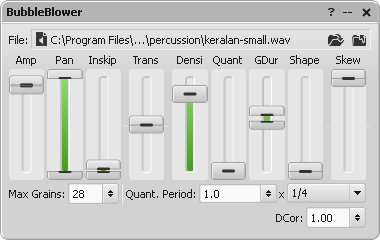| AudioMulch Help > Contraption Reference > Signal Generators | Previous Next |
BubbleBlower
Randomly chops up and scrambles sound files to create fractured or smooth textures (granular synthesis).

BubbleBlower is a granular synthesizer (granulator) that operates on a sample loaded from a sound file. The sample is chopped into small grains that can be output at varying densities, creating clouds of grains ranging from sparse tics to dense drones and textures. Each grain has a randomly determined amplitude, pan, inskip (location in the sample), transposition, duration and envelope shape. In addition to grain density you can quantize grain onset times to create rhythmic patterns. BubbleBlower is limited to using (at most) the first 15 seconds of the loaded sound file.
Many parameters make use of range sliders to specify a range of values; in such cases each grain is assigned a random value from within the specified range. A single value is selected for each grain, and the value doesn't change for the lifetime of the grain.
 |
This contraption synchronizes to the global clock when using the Quant (Quantize) parameters. Remember to press play. |
 |
See the Adjusting Contraption Properties section for information about using sliders, knobs, presets etc. |
 |
See the Loading Sound Files page for information about supported file types and how to load sound files. |
Related Contraptions
Parameters

File |
Selects a pre-recorded sound file to be used as the granulation
source. Click on the Select Sound File button |
Amp (Amplitude) |
Specifies the range of possible amplitude values available for each grain. |
Pan (Panning) |
Specifies the range of possible stereo panning locations available for each grain. |
Inskip |
Specifies the range of possible sample inskips available for each grain. Each grain uses a separately selected segment of the specified file. |
Trans (PitchScaler) |
Specifies the range of possible transposition factors available for each grain. The range is +/- 2400 cents (+/- two octaves) from the original pitch. Positive transposition factors shift the output higher in pitch. Negative factors lower the pitch. Trans affects the rate (speed) at which each grain is played back. |
Densi (Density) |
Specifies the average density of grains, expressed in number of grains per second. |
Quant (QuantizeAmount) |
When the clock is running, BubbleBlower allows the onset times of all grains to be quantized. Set the amount of quantization from none (0%) to total (100%). The clock must be running for Quant to work. |
Q. Period (QuantizePeriodMultiplier) |
The Quantize Period settings below the Quant slider lets you specify the quantization period (spacing of quantization pulses) as a rhythmic unit multiplied by a number.The clock must be running for grain quantization to work. |
Gdur (GrainDuration) |
Specifies the range of possible durations available for each grain. The available range is 5 - 500 milliseconds. |
Shape (AttDecRatio) |
Each grain has an amplitude envelope consisting of an attack, sustain and decay portion. Shape determines the duration of the sustain portion relative to the duration of the attack and decay portions. When shape is 0, the envelope is a triangle, when it approaches 1, the attack and decay portions shorten and the envelope becomes more rectangular. |
Skew (GrainSkew) |
Specifies the range of possible envelope skew factors available for each grain. Skew adjusts the relative duration of the attack and decay portions of the grain envelope. Smaller values of skew decrease the attack time and increase the decay time. Larger values of skew decrease the decay time and increase the attack time. |
Max Grains (MaxGrains) |
Controls the maximum number of simultaneously overlapping grains, ranging from 1-200. Due to the limited processing power of computers, you cannot mix an infinite number of overlapping grains in real time. Even the maximum number of grains in BubbleBlower (200), can be too hard for slower computers to mix. Avoid audio glitches on slower computers by lowering the Max Grains setting. Lower Max Grains settings will, however, result in a thinner texture. |
DCor (Decorrelation) |
Controls the level of correlation/decorrelation between randomized grain parameters. When set to 0, parameters for a single grain are correlated so that, for example, higher pitched grains are panned to the right. When set to 1, the relationship between grain parameters is decorrelated, or completely random. |
Instructions
As the whole sound file is loaded in to the computer's memory (RAM), be careful of using large files if you have a computer with a small amount of RAM. The total amount of RAM used by samples is indicated in the Status Bar at the bottom of the main AudioMulch window.
Relevant Example Files
The following files provide examples of how BubbleBlower can be used:
TempoAutoTimeStretchSim.amh, BBlowerSoundscape.amh, BBMultitracker.amh, MetaSSpatosaurus.amh & PondLife.amh
 |
To open the Example Files directory, go to the File menu, select Open, and double-click on the Examples folder. Read descriptions of the example files here. |
Historical Background
BubbleBlower is a stored sample granulator based on the CloudGenerator program by Curtis Roads and John Alexander.
| Previous Next |

 to choose a file.
Alternatively, drag a sound file into the contraption's sound file slot
directly from the Macintosh Finder or Windows Explorer. The name and
source of the file will be displayed in the sound file slot.
to choose a file.
Alternatively, drag a sound file into the contraption's sound file slot
directly from the Macintosh Finder or Windows Explorer. The name and
source of the file will be displayed in the sound file slot.